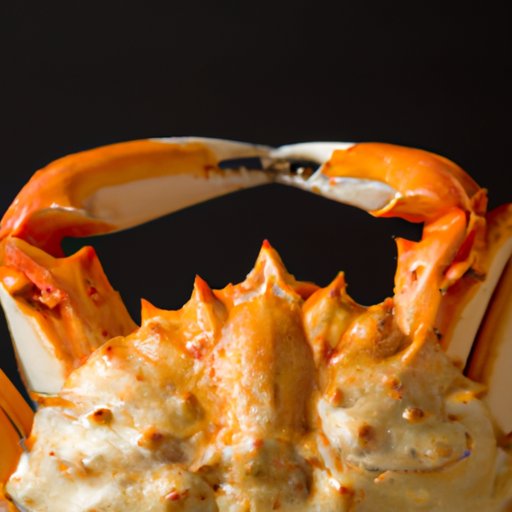
I. Introduction
For individuals with gluten sensitivity or Celiac disease, navigating food options can be a challenging and overwhelming task. With the increasing popularity of gluten-free diets, it is crucial to be aware of the gluten-free status of common foods, including seafood items like imitation crab. This article aims to provide a comprehensive guide for seafood lovers who are wondering, “Is imitation crab gluten free?”
II. Everything You Need to Know About Imitation Crab and Gluten Sensitivity
Before diving into the gluten-free status of imitation crab, it is essential to have a basic understanding of gluten sensitivity and Celiac disease. Gluten is a type of protein found in wheat, barley, and rye that can cause digestive problems and other health issues in individuals with gluten sensitivity or Celiac disease.
Foods to avoid for gluten-free diets include bread, pasta, beer, and other items containing wheat, barley, or rye. However, gluten can also hide in unexpected places, such as sauces, soups, and processed foods.
Imitation crab, also known as surimi, is a processed seafood product made from a combination of fish, starch, and other ingredients. It is a popular and accessible substitute for crab meat in various cuisines, including sushi, salads, and sandwiches.
III. Is Imitation Crab Gluten Free? A Comprehensive Guide for Seafood Lovers
The Food and Drug Administration (FDA) has established regulations for labeling foods as gluten-free. According to their guidelines, foods labeled as gluten-free should contain less than 20 parts per million (ppm) of gluten, a level deemed safe for most individuals with gluten sensitivity or Celiac disease.
Imitation crab can be a gluten-free option, depending on the manufacturing process and ingredients used. While some brands may contain wheat flour or other gluten-containing ingredients, others may be made with gluten-free starches like potato or tapioca. It is crucial to read ingredient labels carefully and look for products that are certified gluten-free by reputable organizations.
However, it is also important to note that the manufacturing process for imitation crab involves multiple steps that could pose a cross-contamination risk with gluten-containing foods. For example, the equipment used to process imitation crab may also be used for processing breaded seafood products that contain gluten. Consumers with severe gluten sensitivity or Celiac disease may want to avoid imitation crab altogether to minimize their risk of exposure.
IV. Is Imitation Crab a Safe Choice for Gluten-Free Dieters? The Answer May Surprise You
Research studies on the gluten levels in imitation crab have produced mixed results. Some studies have shown that imitation crab generally contains low levels of gluten, falling below the FDA’s threshold of 20 ppm. However, other studies have detected higher levels of gluten in some brands and products.
It is important to compare the gluten levels in imitation crab to other gluten-free foods and daily gluten intake recommendations for individuals with gluten sensitivity or Celiac disease. Consuming high amounts of gluten, even from foods labeled as gluten-free, can lead to digestive symptoms, nutrient deficiencies, and other health risks.
V. Imitation Crab: The Gluten-Free Alternative to Real Crab Meat
In addition to being potentially gluten-free, imitation crab also offers advantages in terms of nutrition and cost. Compared to real crab meat, imitation crab is typically lower in calories, fat, and cholesterol. It is also more affordable and accessible in many areas.
Imitation crab also has a mild and versatile taste that can be used in a variety of dishes. It is a common ingredient in sushi rolls, salads, and dips, and can be easily incorporated into other recipes that call for crab meat.
VI. The Truth About Imitation Crab and Its Gluten-Free Status
Despite its potential benefits, there are controversies and misconceptions surrounding the gluten-free status of imitation crab. Some sources may provide misleading information or confuse imitation crab with other seafood products that contain gluten.
It is crucial to seek out credible and trustworthy sources for information on gluten-free diets and food options. Consumers can also reach out to food manufacturers and organizations for clarification on specific products and labeling practices.
VII. Navigating Gluten-Free Seafood: Is Imitation Crab a Safe Bet?
To make informed decisions and reduce the risk of exposure to gluten, individuals with gluten sensitivity or Celiac disease can take several steps. When ordering seafood at restaurants, it is essential to ask about preparation methods and potential cross-contamination risks. Reading ingredient labels and looking for certified gluten-free products is also crucial.
With careful planning and awareness, seafood lovers can enjoy a variety of gluten-free options, including potentially gluten-free imitation crab.
VIII. Gluten-Free Seafood Options: What You Need to Know About Imitation Crab
In conclusion, the gluten-free status of imitation crab depends on the manufacturing process and specific product ingredients. Consumers should look for certified gluten-free products and be aware of potential cross-contamination risks in the manufacturing process.
Imitation crab offers a gluten-free and affordable alternative to real crab meat, with versatility and accessibility in a variety of cuisines. With proper education and awareness, individuals with gluten sensitivity or Celiac disease can navigate gluten-free seafood options and make informed choices.
IX. Conclusion
This article aimed to provide a comprehensive guide for seafood lovers who are wondering, “Is imitation crab gluten free?” By explaining the basics of gluten sensitivity, examining the gluten-free status of imitation crab, and discussing the benefits and potential risks of consuming imitation crab, consumers can make informed decisions and enjoy a variety of gluten-free seafood options.
If you have any further questions or concerns, please do not hesitate to reach out. We welcome your feedback and invite you to explore the many gluten-free options available in seafood and beyond.





